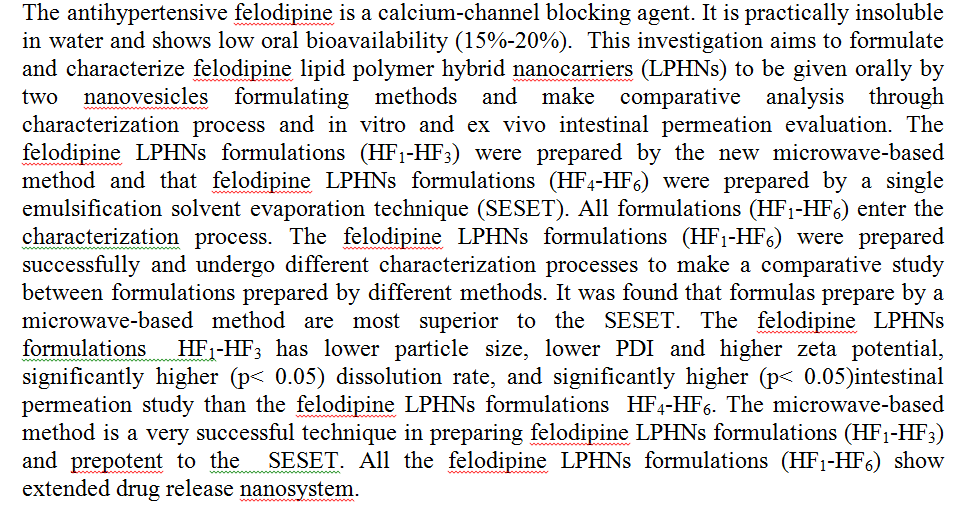With the aim of developing potential antimicrobials, a series of novel Ciprofloxacin methylene isatin derivatives incorporating different aromatic aldehydes were synthesized and characterized by FTIR, 1H NMR, Mass spectroscopy and bases of elemental analysis. In addition, the in vitro antibacterial and antifungal properties were tested against some human pathogenic microorganisms by employing the disc diffusion technique. A majority of compounds were showing activity against several of the microorganisms. The relationship between the functional group variation and the biological activity of the evaluated compounds is discussed. From comparisons of the compounds, 3c was determined to be the most active compound.
 (71)
(71)
 (50)
(50)
In this work, two groups of nanocomposite material, was prepared from unsaturated polyester resin (UPE), they were prepared by hand lay-up method. The first group was consisting of (UPE) reinforced with individually (ZrO2) nanoparticles with particle size (47.23nm). The second group consists of (UPE) reinforced with hybrid nanoparticles consisting of zirconium oxide and yttrium oxide (70% ZrO2 + 30% Y2O3) with particles size (83.98nm). This study includes the effect of selected volume fraction (0.5%, 1%, 1.5%, 2%, 2.5%, 3%) for both reinforcement nano materials. Experimental investigation was carried out by analyzing the thermo-physical properties like thermal conductivity, thermal diffusivity and specific heat for the polymeric composit
... Show More (2)
(2)
 (19)
(19)
 (12)
(12)
Research objective: This research aims to unveil how to use the method of referral in understanding the Holy Quran.
The reason for choosing the research: The one that invited me to write on this topic is the importance of the referral method, so I liked the research in it, and unveiled this wonderful Qur’anic method, so that it helps to understand the intention of God Almighty in his dear book.
The research plan: The research was divided into three topics and a conclusion.
As for the first topic, it is divided into two requirements. The first requirement deals with the definition of referral language.
In the second re
A new, Simple, sensitive and accurate spectrophotometric methods have been developed for the determination of sulfanilamide (SNA) drug in pure and in synthetic sample. This method based on the reaction of sulfanilamide (SNA) with 1,2-napthoquinone-4-sulphonic acid (NQS) to form N-alkylamono naphthoquinone by replacement of the sulphonate group of the naphthoquinone sulphonic acid by an amino group. The colored chromogen shows absorption maximum at 455 nm. The optimum conditions of condensation reaction forms were investigated by: (1) univariable method, by optimizing the effect of experimental variables; (different bases, reagent concentration, borax concentration and reaction time), (2) central composite design (CCD) including
... Show MoreIn the present study, the effect of new cross-section fin geometries on overall thermal/fluid performance had been investigated. The cross-section included the base original geometry of (triangular, square, circular, and elliptical pin fins) by adding exterior extra fins along the sides of the origin fins. The present extra fins include rectangular extra fin of 2 mm (height) and 4 mm (width) and triangular extra fin of 2 mm (base) 4 mm (height). The use of entropy generation minimization method (EGM) allows the combined effect of thermal resistance and pressure drop to be assessed through the simultaneous interaction with the heat sink. A general dimensionless expression for the entropy generation rate is obtained by con
... Show More (5)
(5)
Abstract
In this study, the effect of carboxylic methyl cellulose (CMC), and sodium dodcyl benzene sulfonate (SDBS) as an aqueous solution on the drag reduction was investigated. Different concentrations of (CMC) and (SDBS) such as (50, 100, 150, 200, 250, 300, 350, 400, 450, and 500 ppm) were used to analyze the aqueous solution properties, including surface tension, conductivity, and shear viscosity. The optimum four concentrations (i.e., 50, 100, 200, and 300 ppm) of fluid properties were utilized to find their effect on the drag reduction. Two different PVC pipe diameters (i.e., 1" and 3/4") were used in this work. The results showed that blending CMC with SDBS gives
... Show MoreRealistic implementation of nanofluids in subsurface projects including carbon geosequestration and enhanced oil recovery requires full understanding of nanoparticles (NPs) adsorption behaviour in the porous media. The physicochemical interactions between NPs and between the NP and the porous media grain surface control the adsorption behavior of NPs. This study investigates the reversible and irreversible adsorption of silica NPs onto oil-wet and water-wet carbonate surfaces at reservoir conditions. Each carbonate sample was treated with different concentrations of silica nanofluid to investigate NP adsorption in terms of nanoparticles initial size and hydrophobicity at different temperatures, and pressures. Aggregation behaviour and the
... Show More (52)
(52)
 (48)
(48)
 (6)
(6)
 (6)
(6)
A hierarchically porous structured zeolite composite was synthesized from NaX zeolite supported on carbonaceous porous material produced by thermal treatment for plum stones which is an agro-waste. This kind of inorganic-organic composite has an improved performance because bulky molecules can easily access the micropores due to the short diffusion path to the active sites which means a higher diffusion rate. The composite was prepared using a green synthesis method, including an eco-friendly polymer to attach NaX zeolite on the carbon surface by phase inversion. The synthesized composite was characterized using X-ray diffraction spectrometry, Fourier transforms infrared spectroscopy, field emission scanning electron microscopy, energy d
... Show More (3)
(3)

